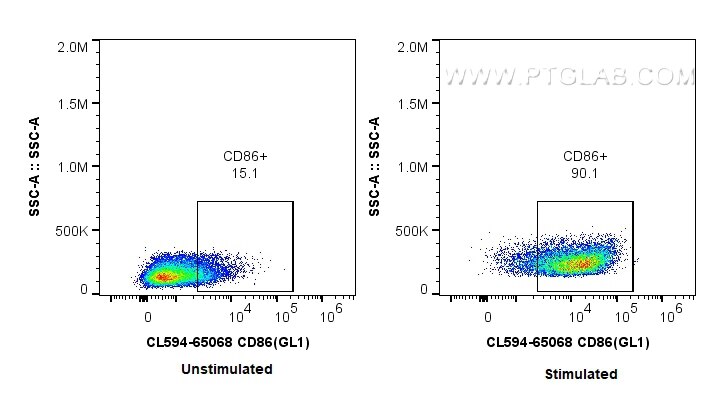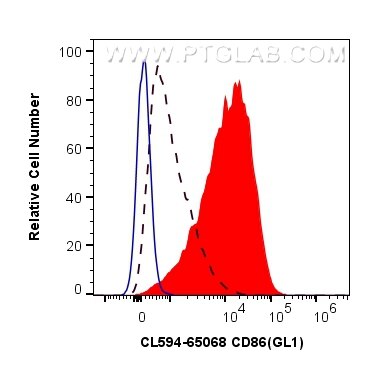Validation Data Gallery
Tested Applications
| Positive FC detected in | LPS treated mouse splenocytes |
Recommended dilution
| Application | Dilution |
|---|---|
| This reagent has been tested for flow cytometric analysis. It is recommended that this reagent should be titrated in each testing system to obtain optimal results. | |
| Sample-dependent, Check data in validation data gallery. | |
Product Information
CL594-65068 targets CD86 in FC applications and shows reactivity with Mouse samples.
| Tested Reactivity | Mouse |
| Host / Isotype | Rat / IgG2a, kappa |
| Class | Monoclonal |
| Type | Antibody |
| Immunogen | LPS-activated CBA/Ca mouse spleen B cells 相同性解析による交差性が予測される生物種 |
| Full Name | CD86 antigen |
| GenBank accession number | BC013807 |
| Gene Symbol | Cd86 |
| Gene ID (NCBI) | 12524 |
| RRID | AB_3084654 |
| Conjugate | CoraLite®594 Fluorescent Dye |
| Excitation/Emission maxima wavelengths | 588 nm / 604 nm |
| Form | Liquid |
| Purification Method | Affinity purification |
| UNIPROT ID | P42082 |
| Storage Buffer | PBS with 0.09% sodium azide. |
| Storage Conditions | Store at 2-8°C. Avoid exposure to light. Stable for one year after shipment. |
Background Information
CD86 (also known as B7-2) is a costimulatory molecule belonging to the immunoglobulin superfamily. Primarily expressed on antigen-presenting cells (APCs), including B cells, dendritic cells, and macrophages, CD86 is the ligand for two proteins at the cell surface of T cells, CD28 antigen and CTLA-4. Binding of CD86 with CD28 antigen is a costimulatory signal for activation of the T-cell. Binding of CD86 with CTLA-4 negatively regulates T-cell activation and diminishes the immune response. (PMID: 7513726; 1847722; 11029388; 27591335)
Protocols
| Product Specific Protocols | |
|---|---|
| FC protocol for CL594 CD86 antibody CL594-65068 | Download protocol |
| Standard Protocols | |
|---|---|
| Click here to view our Standard Protocols |

